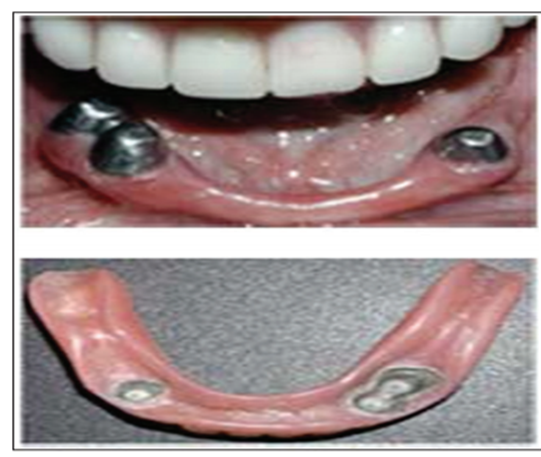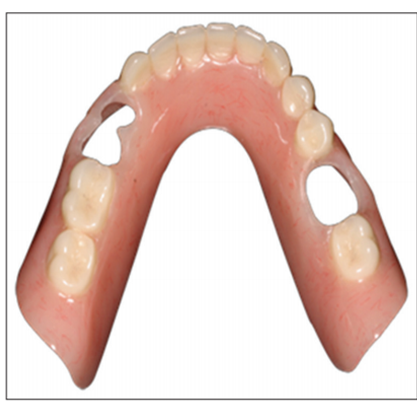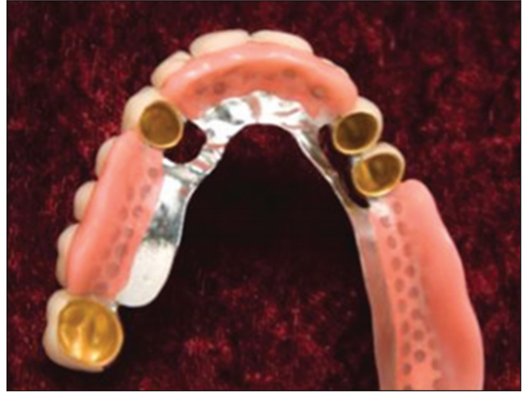The choice of various therapeutic
choices to replace missed teeth is affected by health, and dental and patient
factors. Replacement of missing teeth is one of the most significant needs to
restore esthetics and/or work for patients attending clinics. Many treatment
modalities are required to restore missing teeth; partial removable denture
(RPD), partial fixed denture, or dental implant. Every modality is a potential
treatment choice and has its own pros and cons.
Removable partial dentures had become common with the emergence of acrylic polymers and cobalt chrome alloys in dentistry many decades ago. Many patients opt for removable partial dentures due to cost-to-psychology factors. Dr. Walter Wright (1937) presented polymethyl methacrylate as a base material for the denture that became the main polymer to be used. Polymethyl methacrylate (PMMA) has been used for manufacturing the dentures for ages. Aluminum cast / metal frame / base metal dentures are also made to repair the defects. Some of the acrylic issues are difficult to tackle, such as placement in undercut regions, methyl fragility Methacrylate that contributes to fracture, and methyl methacrylate monomer allergy. Flexible removable part-dentures have become really common in recent times.
A path of insertion which is nearly perpendicular to the current occlusal plane is used when designing a traditional removable partial denture. The cast is positioned in such a way that the occlusal plane is perpendicular to the surveyor's analyzing rod. Reasons for using this insertion path are (1) the contours of the abutment teeth surveyed in this position typically found beneficial retentive undercuts; (2) guiding planes could be easily incorporated; (3) the placement path can be easily repeated; and (4) because many patients sit under occlusal force, a lower incidence of permanent clasp distortion is likely to occur because of the occlusal force. Alterations from such an insertion path are often indicated to compensate for the lack of the ideal position of the dent or contours. The changed insertion direction is calculated by adjusting the lateral or anteroposterior tilt of the on-screen cast.
Swing-lock RPD
In 1963, Simmons introduced the Swing-lock RPD
to the dental profession. It consists of a labial / buccal holding bar hinged
at one end and locked with a latch at the other, reciprocating the lingual
plate together to achieve maximum retention and stability. [Figure 3]
For people with poor oral hygiene, insufficient
physical ability, deep vertical overbite with negligible horizontal overjet
which does not allow a lingual plate for a maxillary prosthesis, a swing-lock
RPD should not be used. Increased frenal attachment or Prominent labial alveolar
ridge without any labial undercut. Short lip or small vestibular depth found .
Overdenture is a removable partial or complete denture which covers and
rests on one or more remaining natural teeth, roots and/or dental implants; a
dental prosthesis which covers and is partially supported by natural teeth,
tooth roots and/or dental implants. It is also known as overlay denture,
overlay prosthesis, and prothesis superimposed. [Figure 4]
Indication: patients with few remaining retainable teeth in an arch; as well as
patients with ill-related ridge cases; patients requiring single denture, or
unfavorable tongue positions, muscle attachments, and high palatal vault,
making the stability and retention of the prothesis difficult.
Contraindications:
patients with questionable oral prophylaxis, systemic complications and
insufficient distance between arches.
Advantages
-- Alveolar bone preservation, proprioception, enhanced stability and
vertical dimensional retention and maintenance of the occlusion.
-- Patients with congenital defects such as oligodontia, cleft palate,
cleidocranial dysostosis, and Class III occlusion are also useful.
-- Overdenture can easily be converted over a period of time into full
denture.
-- Arch-form harmony.
The disadvantages are: susceptibility to caries, over contour, under
contour, Esthetics, Meticulous oral hygiene and costly approach with frequent
patient recall checks compared to conventional removable complete denture [7].
Nesbit denture
Nesbit dentures are a
variation of the traditional RPDs used on the same side of the upper or lower
arch to restore one – three missing teeth. They provide a low-cost option using
development of new technology to replace missing teeth, whereby no metal clasps
are fitted around supporting teeth on either side of the gap, to prevent the
denture from settling into your oral mucosa. Compared to the regular partial
denture, the result is a much smaller and more relaxed prosthetic.
|
|
Cu-Sil Partial Denture
Cu-Sil
dentures are meant to protect the few surviving natural teeth and also the
alveolar bone. They get an impact on denture retention and stability. It also
gives the patient sense of satisfaction of retaining the natural teeth just as
they were. The retained natural teeth preserve vertical dimension and
proprioception. Add-on devices are
They offer a solution for single or separated
teeth that are present in the dental arch. They are not implied for patients
with large amounts of teeth spread equally across the dental arch. There are
also some disadvantages to consider with those dentures. The soft liner used
has a limited performing duration of 3 years. [8]
Implant-Supported RPD
|
|
Telescopic Denture
Though first described by Starr
in 1886, at the beginning of the 20th telescopic copings were originally
introduced as retainers for RPDs. Because of her resemblance to the collapsible
optical telescope became recognized as the telescopic denture, this system of
the double crowns which can be fitted into one another. Telescoping refers to
the use of a quality system-cover casting (coping / male telescopic portion)
lubricated to the prepared tooth with a secondary casting (superstructure /
secondary crown / female telescopic portion), which is part of the denture framework
and is retained over the primary casting by means of interfacial surface
tension. They act by switching forces along the direction of the abutment
teeth's long axis as well as provide guidance, support and protection against
movements that could dislodge the RPDs. Telescopic crowns can also be used as
indirect retainers to prevent dislodgement away from the edentulous ridge of
the distal extension base. [Figure 8][10]
-- Creation of a common
insertion path, and easy oral hygiene routine.
-- Rigid splinting action, so
the abutment teeth receive stress.
|
|
The disadvantages are:
increased cost, complex laboratory procedures, extensive tooth decrease and
increased number of dental appointments required. Often, the accomplishment of
esthetics and preservation is challenging.
Fixed RPD (Andrew’s Bridge)
Dr. James Andrews, from Amite,
Louisiana, introduced the fixed removable Andrews Bridge System (Cosmetic
Dentistry Institute, Amite, La.). [Fig. 9]
Proper cases
1. Patients whose residual ridge
is related to the opposing dentition which would prohibit the esthetic placement
of a fixed partial denture in the pontics.
2. Patients required to
harmonize natural dentition with diastemas.
3. Patients suffering extensive
loss of alveolar bone and tissue.
Advantages: Decreases denture size, taking
reduced vertical and horizontal space with Four separate bar curvatures
covering the ridge and allowing for anterior use of the rim. It also restores
one – four teeth of varying lengths and the denture ensures strong preservation
with no wear and high tensile strengths and yield strengths.
-- Failure due to insufficient
soldering, as it is technically sensitive procedures.
|
|
Flexible Denture
Flexible dentures are commonly
used in situations where conventional dentures create patient pain. In nearly
any partial edentulous condition, versatile RPDs are suggested as long as the
patients are willing to hold a temporary implant in their mouth. Flexible
denture uses material made from polyamide nylon. Flexible partial dentures use
the undercuts in the surface for preservation, so they are shown on ridges
where there are bilateral undercuts. Patients with tilted teeth (due to a long
period of missing adjacent tooth) develop an undercut in which rigid partial
denture is difficult to insert. [Figure 10]
Indications
-- Flexible partial dentures can
solve the problem of casting partial dentures in patients who are allergic to
nickel.
-- Patients with big,
unremovable bony exostoses, versatile partial dentures display strong
Benefits
-- The flexibility of the
material allows the undercut under the bony exostoses, that is, in rigid
partial dentures it is not possible
-- Other perks, such as:
Unbreakable, Lightweight, Improved esthetics and ease of manufacturing.
|
|
-- Only intended for temporary
or provisional use.
-- Acrylic teeth debonding from
nylon denture base.
-- Tend to absorb water content
and become discolourated.
-- High surface roughness and
low hardness, and sensitive to technical requirements.
Non-metal Clasp Denture
|
|
Light Polymerized Partial Denture
|
|
















No comments:
Post a Comment